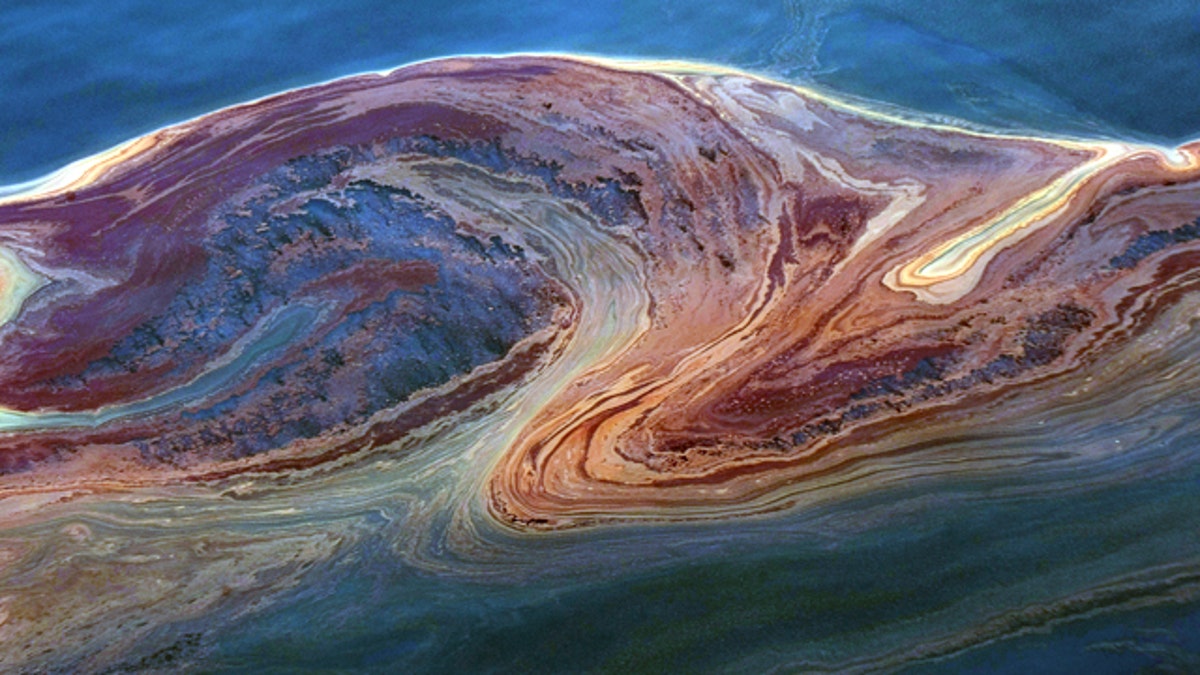
Oil that leaked from a broken oil well following an explosion on a drilling rig swirls through the currents in the Gulf of Mexico. (AP Photo/Dave Martin)
The largest ecological disaster in U.S. history has largely been taken care of, the government claims.
Many scientists aren't so sure, however.
In a five-page report, the National Oceanic and Atmospheric Administration (NOAA) claimed "a vast majority" of the BP oil spill is now completely gone. The remaining 25% consists of residual oil that is buried in sediments and sand.
The report, released August 4, claims that most of the oil evaporated naturally or -- through what the report calls a "robust federal response" -- was skimmed, burned, recovered, or dispersed. As the report came out on his 49th birthday, President Obama thanked the NOAA for the well-timed gift.
But researchers and scientists as well as environmental groups and Gulf residents have cried foul, saying the NOAA report unfairly claims "mission accomplished," an attitude that flies in the face of reality.
"There is still considerable oil in the Gulf as residual oil -- and that 25% is still 'oil' oil," said Justin Revenaugh, a seismologist and professor of geology and geophysics at the University of Minnesota.
Revenaugh told FoxNews.com that the residual oil is still a massive spill, five times that of the Exxon Valdez and the 11th largest in history. It’s also still extremely harmful to the environment, he said.
Defining oil accurately
Several other scientist and oceanographers have criticized the NOAA report more directly. At issue is how the report describes oil -- vastly gone, and not a lingering deposit that will affect the environment.
John Kessler, an oceanographer from Texas A&M, is one of the report's most outspoken critics. He estimates that as much as 75% of the BP oil spill is still in the Gulf and traceable, and he called the NOAA report "misleading if not totally inaccurate" in a news release.
Ian MacDonald, an oceanographer at Florida State University, told FoxNews.com that the report "mixes apples and oranges, then counts everything as apples" because it uses hard data on skimming, burning and chemical dispersion with conjecture on natural dispersion and dissolution.
And Dr. Larry McKinney, executive director of the Harte Research Institute for Gulf of Mexico Studies, believes there are still oil deposits in the water columns and in sediment layers.
Still, McKinney thinks the NOAA used "a reasonable and thoughtful process. When you look at the actual report, there are the types of caveats that any exercise of this type might include. I do not think it likely we will have a better estimate, but some improvements might be possible as additional data come in."
Environmental angst?
Not all scientists are critical of the NOAA report. Peter Lane, the chairman of the ASTM F20 Committee on Oil Spills and Hazardous Substances, who is also the president of Applied Fabric Technologies, an oil spill clean-up equipment company, agreed with its conclusions.
"I thought the oil was gone or was going to be gone about five days after the blowout," said Lane. "The rest is just backpedaling by those who made dire predictions about the long-lasting effects of oil going all over the world."
"They have no idea how to put something like this into perspective, they want to shed blame on someone and/or gain political mileage," he added.
Interestingly, Lane said those who are critical of the clean-up process are usually uninformed about what is required for the clean-up efforts -- armchair quarterbacks for oil spills.
"The oil industry and BP were the only ones prepared in any way to do anything," Lane said. "The [United States Coast Guard] and Navy have equipment which they contributed, the USCG has some personnel who helped on oversight, but the rest of them are first-time spill fighters who are learning from a clean sheet of paper."
While researchers have taken issue with the process used to evaluate the remaining oil deposits, the NOAA defended its process as highly scientific and thorough.
"Scientists have been conducting ongoing testing for subsurface oil using a number of techniques, including the use of fluorometric and acoustic scanning, monitoring of dissolved oxygen in the water column, and collecting water samples for detailed chemical analysis in the laboratory," said Chris Vaccaro, an NOAA spokesperson.
"Research vessels owned and operated by NOAA and by our academic partners have been continuously testing the subsurface oil since this disaster began and will continuing doing so since we know oil still exists below the surface," he told FoxNews.com
In the end
On one issue all sides seem to agree: The long-term impact of the oil spill is still a concern. NOAA head Jane Lubchenco, speaking at a press briefing last week, made it clear that the oil leak's effects will linger, though the NOAA claims the oil is mostly gone.
"We remain concerned about the long-term impacts, both on the marshes and the wildlife, but also beneath the surface, and are actively studying that, both as part of our federal response and in partnership with much of the academic community that is also very interested in the overall long-term impacts of this," she said.
